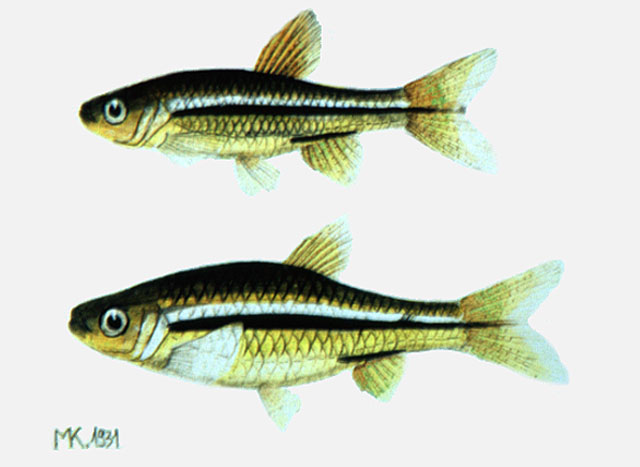| Danionidae (Danios), subfamily: Rasborinae |
| 3.9 cm SL (male/unsexed) |
|
benthopelagic; freshwater |
| Asia: Lake Laut Tawar and several of its tributary rivers in Sumatra, Indonesia (Ref. 85846; and probably Malaya (Ref. 7050). |
|
Dorsal soft rays (total): 9-9; Anal soft rays: 7-7; Vertebrae: 31-32. Distinguished from all members Rasbora trifasciata-group by having male cephalic tubercles conical, distinctly pointed, with shallow, wide depression basally, and an axial streak
bordering the dorsal margin of the black midlateral stripe along its posterior portion, barely traversing the stripe (vs. traversing the medioposterior portion of the black midlateral stripe). Can be further diagnosed from other members in northwestern Sumatra by the following combination of characters: presence of cranial superficial neuromasts (each basal plate of the neuromast is confluent with the skin surface and surrounded by a peripheral groove); first infraorbital (lachrymal) with a posterodorsal process and a concave dorsal margin; the uniformly pigmented lachrymal region; a dorsomedial branch of the supraorbital canal extending toward the posterior margin of the frontal; the cephalic tubercles, which are present only in males; a pigmented opercular flap; a transverse scale count anterior to the dorsal-fin origin and pelvic-fin insertion of K4/1/2K; 12 scales around caudal peduncle; a basal reticulation pattern consisting of a network of well-developed parenthesis-shaped bars on the midlateral surface of the body; the maximum vertical coverage of the basal reticulation by four and a half longitudinal scale rows; all scales of the lateral line series that are pigmented as a continuation of the basal reticulation; and pelvic-fin rays i,7 (Ref. 85846).
Description: Dorsal-fin rays ii, 7½; anal-fin rays ii, 5½; pectoral-fin rays i, 13; pelvic-fin rays i, 7; all scales perforated, 24-26 + 2-3; scales in lateral series 25-27 + 2-3; gill rakers on 1st gill arch 13-14; black basicaudal spot absent; all fins hyaline except for slight yellow coloration on basal sections of dorsal- and caudal-fin rays (Ref. 94947). |
|
|
Least Concern (LC); Date assessed: 09 January 2019 Ref. (130435)
|
| harmless |
Source and more info: www.fishbase.org. For personal, classroom, and other internal use only. Not for publication.

